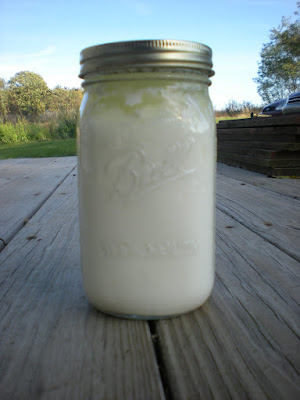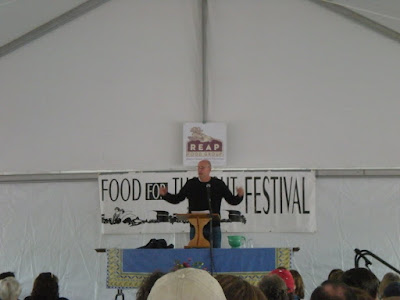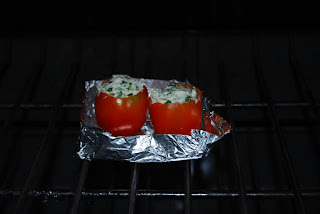
We spend the day after Thanksgiving with my parents, the Lapps. It has become our tradition to make a modified version of
Vegetarian Times' holiday menu of the year. This year, the theme was
Soul Celebration, which featured: Butternut Squash-Bartlett Pear Soup; Citrus Collards with Raisins; Smothered Seitan Medallions in Mixed Mushroom Gravy, Cumin-Cayenne Mashed Potatoes with Caramelized Onions, and our personal addition: squash pie with freshly-whipped heavy cream.
Vegetarian Times' menu also included Carrot-Cranberry Salad and a Chocolate-Pecan Pie, but we opted to skip those.
We began the day by making the mushroom broth needed for the gravy. The recipe made way more than we needed, so we now have lots of broth frozen for future use. Quite yummy! Even all alone.
'Shroom Stock (makes six cups)
1 Tbs. olive oil
1 lb. button mushrooms, thinly sliced
1 lb. portobello mushrooms, thinly sliced
4 celery ribs, thinly sliced
1 large onion, diced (including skin)
1 large carrot, thinly sliced
2 oz. dried-shitake mushrooms
6 cloves garlic, unpeeled
(I think we used more!)
2 bay leaves
3 sprigs thyme
(still picking from the herb garden...amazing!)
1/2 ts. coarse sea salt
1/8 tsp. cayenne pepper
Saute all ingredients in pot for 5 minutes. Add 9 cups of water; simmer 1 hour. Strain.
PER 1-CUP SERVINGS: 30 CAL, 0 G PROT; 2 G TOTAL FAT; 2 G CARB; 0 MG CHOL; 184 MG SOD; 1 G SUGARS
Next, we made the Butternut-Squash Bartlett Pear Soup. We've made plenty of different squash/pear soup combinations in the past, but this is the first one which called for coconut milk. We felt a bit guilty buying a product that is so obviously not local, but we decided to indulge on such a product anyway. The coconut milk added a nice creamy texture and sweet flavor to the soup that we haven't had in our other recipes.
We had so much of this that we were able to get through the whole next week of work with this soup as our lunch.
Butternut Squash-Bartlett Pear Soup (makes six cups)
3 Tbs. olive oil
2 medium leeks, white and tender green parts finally chopped (3 cups) ~
from our box!
1 small butternut squash, peeled, cored, and cut into 1-inch pieces (2 lbs) ~
from our freezer!
3 Bartlett pears, peeled, cored, and cut into 1-inch pieces (1 1/2 lb) ~
from our box!
5 cups low-sodium vegetable broth ~
from our freezer!
1 14-oz can light coconut milk ~
eeks! from the Caribbean!
1 tsp. chopped fresh thyme ~
from our garden!
Pumpkin seeds for garnish, optional
~ we didn't do this!
1. Heat oil in saucepan over medium-low heat. Add leeks, and cook 10 minutes, or until soft. Stir often.
2. Add squash and pears, and saute 5 minutes. Stir in vegetable broth, and bring to a boil. Reduce heat to medium-low, and add salt, if desired. Simmer 20 minutes, or until squash if fork-tender.
(We didn't add our squash here because we used pureed squash from our freezer; you'd only add it here if you were using fresh squash.)
3.
Remove from heat, and stir in coconut milk
(this is where we added our squash). Puree soup in batches in blender or food processor. Blend until smooth. Return soup to saucepan, and stir in thyme. Reheat over medium-low heat 2 to 3 minutes, or until warmed through. Season with salt and white pepper, if desired. Serve with pumpkin seeds, if using.
PER 1 CUP SERVINGS: 264 CAL; 3 G PROTEIN; 13 G TOTAL FAT (5 G SAT. FAT); 37 G CARB; 0 MG CHOL; 138 MG SOD; 8 G FIBER; 15 G SUGAR
While Andy got the soup finished, I began the Mixed Mushroom Gravy.
Mixed Mushroom Gravy (makes 2 cups)
2 Tbs. olive oil
1/4 lb. button mushrooms
1/4 b. baby bella mushrooms
2 Tbs. all-purpose flour
1 cup unflavored rice milk
(we used cow's milk)
1 cup 'Shroom Stock
(made earlier)
1/2 tsp. salt
1/2 tsp. white pepper
(we used black pepper)
1. Heat 1 Tbs. olive oil in saucepan over medium heat. Add all mushrooms, and saute for 5 minutes. Stir in flour and remaining 1 Tbs. oil. Reduce heat to low, and cook 10 minutes, or until flour begins to brown, whisking constantly.
2. Whisk in milk, 'Shroom Stock, salt, and pepper. Simmer 15 minutes, or until thickened, whisking often.
PER 1/3 CUP SERVINGS: 77 CAL; <1>
Once finished with the gravy, I began the Smothered Seitan Medallions in Mixed Mushroom Gravy.
Smothered Seiten Medallions in Mixed Mushroom Gravy (inspired by smothered pork chops) ~
makes 9 cups
1 lb. seitan, cut into medallions
5 Tbs. arrowroot powder
1 cup pus 2 Tbs. olive oil, divided
1 large onion ~ from our box!
5 cloves of garlic
2 cups Mixed Mushroom Gravy
(made earlier)
2 cups 'Shroom Stock
(made earlier)
1 cup finely chopped green cabbage
~ from our box!
2 jalapeno chiles, minced
1/4 cup thinly sliced green onions
2 Tbs. chopped parsley ~
from our herb garden!
1. Coat seiten pieces with arrowroot.
2. Heat 1/2 cup oil in skillet over medium-high heat. Fry half of seitan in oil 3 minutes per side. Transfer to paper-towel-lined plate. Discard oil, wipe out skillet, and repeat with 1/2 cup oil and remaining seiten. Discard.
3. Add remaining 2 Tbs. oil and onion in hot skillet. Increase heat to high, and saute 3 minutes. Reduce heat to medium, and saute 3 minutes. Stir in Mixed Mushroom Gravy, 'Shroom Stock, and seiten. Cover, and simmer 30 minutes. Add cabbage, and cook 3 minutes. Stir in jalapenos, green onions, and parsley.
PER 1. 5 CUP SERVINGS: 287 CAL; 22 G PROTEIN; 13 G TOTAL FAT (2 G SAT. FAT); 21 G CARB; 0 MG CHOL; 302 MG SOD; 2 G FIBER; 5 G SUGAR
Next on the agenda was to get the potatoes ready! These potatoes were truly magnificent! I imagine that I will whip these up again, with or without the gravy. These would go perfectly with a piece of Willy Street Co-op's Southern Fried Tofu, or for you omnivores out there, I would guess that these potatoes would go well with any type of meat.
Cumin-Cayenne Mashed Potatoes with Caramelized Onions (makes 4.5 cups)
2 lb Potatoes, peeled and cubed
~ from our garden!
1 large onion
~ from our box!
5 Tbs. olive oil
2 Tbs. ground cumin
1/2 tsp. salt
1/4 tsp. salt
1/4 tsp. cayenne pepper
1/2 cup unflavored rice milk
(we used cow's milk)
2 Tbs. thyme
~ from our herb garden
1. Boil potatoes in enough water to cover 25 minutes, or until soft.
2. Meanwhile, saute onion, oil, cumin, salt, and cayenne in skillet over low heat 30 minutes, or until browned. Stir in rice milk and thyme.
3. Drain potatoes, and mash. Whisk onion mixture into potatoes. Season with salt and pepper, if desired.
PER 3/4 CUP SERVINGS: 277 CAL; 4 G PROTEIN; 12 G TOTAL FAT (2 G SAT. FAT); 40 G CARB; 0 MG CHOL; 213 MG SOD; 4 G FIBER; 4 G SUGAR
Right before serving up dinner, we made the personal highlight for my taste buds ~ Citrus Collards with Raisins! Even writing this right now, my mouth is watering! This dish was perfectly sweet, bitter, and citrusy. The raisins added a nice texture, and the orange juice lightened up the taste of the greens. This is a keeper!
Citrus Collards with Raisins (makes 3 cups)
1 1/2 lb collard greens, tough stems trimmed
1 Tbs. olive oil
2 cloves garlic, minced
2/3 cup raisins
1/2 tsp. salt
1/3 cup freshly squeezed orange juice
~ oranges from our fruit box!
1. Stack several collard greens atop one another, and roll into a tight cylinder. Slice crosswise into strips.
2. Cooks greens in a large pot of boiling, salted water 8 to 10 minutes, or until softened. Drain, and plunge into large bowl of cold water to stop cooking.
3. Heat oil in large skillet over medium heat. Add garlic, and saute 1 minute. Add drained collards, raisins, and salt, and saute 3 minutes. Stir in orange juice, and cook 15 seconds more. Season with salt and pepper, if desired.
PER 1/2 CUP SERVINGS: 105 CAL; 3 G PROTEIN; 3 G TOTAL FAT (LESS THAN 1 G SAT FAT); 21 G CARB; O MG CHOL; 65 MG SOD; 3 G FIBER; 12 G SUGAR
Getting all of this on the table at the same time was a trick and was not successfully done! We haven't cooked this many dishes at once for quite a while, and we underestimated the time it would take to make the seiten medallions. Luckily, my parents are very flexible. We ended up having the soup early to tide us over. Hours later, we had the rest of dinner. We paired this all with a nice, robust, and fruity Zinfandel.
We ended the feast with homemade squash pie. Earlier this year, we pureed and froze several bags of squash. Our Thanksgiving would have been much more stressful had it not been for those bags of orange goodness waiting for us in the freezer. Our pies were among the easiest of the dishes for this party because of that advance preparation. The addition of freshly whipped cream was splendid!
Squash Pie
3 cups roasted, pureed squash
1 c sugar
1.5 tsp. ground cinnamon
1 tsp. ground cloves
1 tsp. ground allspice
1/2 tsp. ground ginger
1/2 tsp. vanilla extract
1/2 tsp. salt, optional
4 large eggs
1.5 cans of evaporated milk
1. Strain the squash puree to rid excess water. This can be done the night before; it should typically strain for four hours or more.
2. Once the squash is strained, mix all ingredients together and put into a pie crust. We got a yummy "from scratch" pre-made pie crust from the Willy Street Co-op.
3. Bake at 425 F for the first 15 minutes, then turn the temperature down to 350 F and bake another 45 to 60 minutes, until a clean knife inserted into the center comes out clean.
4. Whip up some heavy whipping cream, sweetened with sugar and vanilla, and garnish pie! Yum!


 there was no question as to where we'd get the recipe. Now this recipe might take some interpretation based on your culinary abilities, but who am I to alter the words of a family tradition? Here is the recipe, word-for-word as given to us, and I quote:
there was no question as to where we'd get the recipe. Now this recipe might take some interpretation based on your culinary abilities, but who am I to alter the words of a family tradition? Here is the recipe, word-for-word as given to us, and I quote:













































